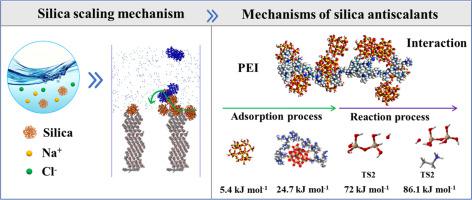当前位置:
X-MOL 学术
›
Water Res.
›
论文详情
Our official English website, www.x-mol.net, welcomes your feedback! (Note: you will need to create a separate account there.)
Insights into the silica scaling behaviors in membrane distillation and anti-scaling mechanism of functional polymers
Water Research ( IF 11.4 ) Pub Date : 2024-06-27 , DOI: 10.1016/j.watres.2024.122006 Shideng Yuan , Na Zhang , Shiling Yuan , Zhining Wang
Water Research ( IF 11.4 ) Pub Date : 2024-06-27 , DOI: 10.1016/j.watres.2024.122006 Shideng Yuan , Na Zhang , Shiling Yuan , Zhining Wang

|
Silica scaling imposes a significant limitation on the efficacy of membrane distillation (MD) in the treatment of hypersaline wastewater. The complex dynamic behaviors of silica at the membrane-water-air interface and the poor understanding of molecular-level anti-scaling mechanism hampers the development of effective antiscalants for mitigating silica scaling in MD. Despite using functional polymers to prevent silica polymerization, the inhibition mechanisms are unclear. Here, the kinetic process of silica scaling during MD and the potential anti-scaling mechanism of poly-ethylenimine (PEI) were investigated at the molecular level via molecular dynamics simulations. The investigation reveals that silica scales were more likely to adhere to the water-PTFE interface with a free energy potential well of -40.0 kJ mol than that of the water-air interface with a -11.4 kJ mol potential well. Silica scales falling at the water-air interface also migrated on the water-air interface until captured by the PTFE membrane. In this work, a representative functional amino-rich polymer PEI was constructed as silica inhibitors and its scale inhibition mechanism was elucidated. Notably, the inclusion of PEI increased the free-energy barriers for the silica polymerization reaction from 72.0 kJ mol to 86.1 kJ mol, compared to scenarios without the antiscalants. Moreover, quantitative structure-activity relationships (QSAR) model of was developed to predict the anti-scaling efficiencies of typical antiscalants based on machine learning method. These findings provide valuable insights into enhancing the efficiency of silica scaling mitigation strategies.
中文翻译:

膜蒸馏中二氧化硅结垢行为及功能聚合物防垢机理的见解
二氧化硅结垢严重限制了膜蒸馏 (MD) 处理高盐废水的效果。二氧化硅在膜-水-空气界面的复杂动态行为以及对分子级防垢机制的了解不足,阻碍了有效缓解MD中二氧化硅结垢的防垢剂的开发。尽管使用功能聚合物来防止二氧化硅聚合,但其抑制机制尚不清楚。在这里,通过分子动力学模拟在分子水平上研究了MD过程中二氧化硅结垢的动力学过程以及聚乙烯亚胺(PEI)潜在的防垢机制。研究表明,与自由能势阱为-11.4 kJ mol 的水-空气界面相比,硅垢更容易粘附在自由能势阱为-40.0 kJ mol 的水-PTFE 界面上。落在水-空气界面上的硅垢也会在水-空气界面上迁移,直到被 PTFE 膜捕获。本工作构建了具有代表性的功能性富氨基聚合物PEI作为二氧化硅抑制剂,并阐明了其阻垢机理。值得注意的是,与不含阻垢剂的情况相比,PEI 的加入将二氧化硅聚合反应的自由能势垒从 72.0 kJ mol 增加到 86.1 kJ mol。此外,基于机器学习方法,开发了定量构效关系(QSAR)模型来预测典型阻垢剂的阻垢效率。这些发现为提高二氧化硅结垢缓解策略的效率提供了宝贵的见解。
更新日期:2024-06-27
中文翻译:

膜蒸馏中二氧化硅结垢行为及功能聚合物防垢机理的见解
二氧化硅结垢严重限制了膜蒸馏 (MD) 处理高盐废水的效果。二氧化硅在膜-水-空气界面的复杂动态行为以及对分子级防垢机制的了解不足,阻碍了有效缓解MD中二氧化硅结垢的防垢剂的开发。尽管使用功能聚合物来防止二氧化硅聚合,但其抑制机制尚不清楚。在这里,通过分子动力学模拟在分子水平上研究了MD过程中二氧化硅结垢的动力学过程以及聚乙烯亚胺(PEI)潜在的防垢机制。研究表明,与自由能势阱为-11.4 kJ mol 的水-空气界面相比,硅垢更容易粘附在自由能势阱为-40.0 kJ mol 的水-PTFE 界面上。落在水-空气界面上的硅垢也会在水-空气界面上迁移,直到被 PTFE 膜捕获。本工作构建了具有代表性的功能性富氨基聚合物PEI作为二氧化硅抑制剂,并阐明了其阻垢机理。值得注意的是,与不含阻垢剂的情况相比,PEI 的加入将二氧化硅聚合反应的自由能势垒从 72.0 kJ mol 增加到 86.1 kJ mol。此外,基于机器学习方法,开发了定量构效关系(QSAR)模型来预测典型阻垢剂的阻垢效率。这些发现为提高二氧化硅结垢缓解策略的效率提供了宝贵的见解。











































 京公网安备 11010802027423号
京公网安备 11010802027423号